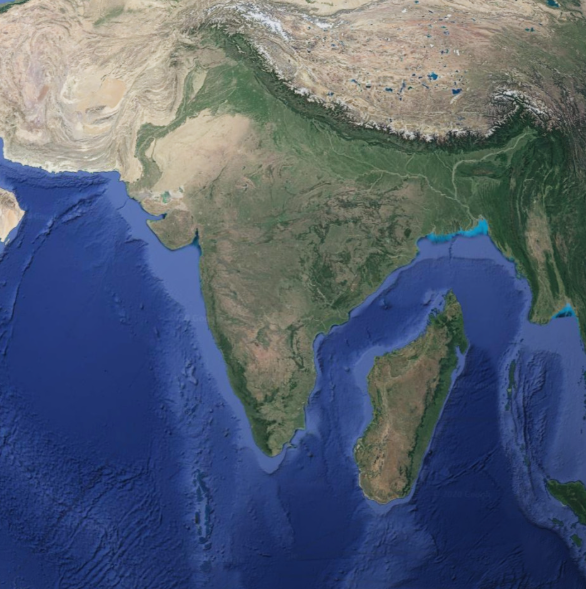Geographical Map of Madagascar Next to India


Marcus Rodriguez
Historical Geography Expert
Marcus Rodriguez specializes in historical cartography and geographic data analysis. With a background in both history and geography, he brings unique...
Geographic Analysis
What This Map Shows
The map titled "Geographical Map of Madagascar Next to India" provides a clear visual representation of the spatial relationship between Madagascar and India, two significant landmasses in the Indian Ocean region. This visualization highlights their geographical proximity, including surrounding water bodies, and offers context for understanding various geographical features, ecosystems, and cultural ties that exist between the two locales.
Interestingly, while Madagascar and India are separated by roughly 3,200 kilometers, their historical connections and ecological similarities are profound. The map serves as a foundation for exploring not just their geographical locations, but also diving deeper into the rich tapestry of ecological, cultural, and historical narratives that connect these two regions.
Deep Dive into Madagascar and India
Madagascar, the fourth largest island in the world, is renowned for its biodiversity. With over 90% of its wildlife found nowhere else on Earth, Madagascar boasts unique flora and fauna, including the famous lemurs and the baobab trees. The island's distinct ecosystems range from rainforests to desert areas, making it a hotspot for conservation efforts. The climate varies significantly across the island, influenced by its geographic orientation and topography. The eastern coast experiences a tropical climate, while the interior has a more temperate climate.
On the other hand, India, a vast subcontinent, is equally diverse in its ecological offerings. It ranges from the Himalayan mountain range in the north to the coastal plains in the south, showcasing deserts, forests, and rich agricultural lands. India’s climate is equally varied, influenced by the monsoon winds, which play a crucial role in the agricultural cycle of the country. It's fascinating to note that India is home to a significant portion of the world's population, with over 1.4 billion people, which has resulted in densely populated urban areas, particularly in cities like Mumbai and Delhi.
Moreover, both Madagascar and India share a rich cultural heritage. The people of Madagascar, known as Malagasy, have a unique identity influenced by a blend of African, Asian, and European cultures. Traditional practices, languages, and customs reflect this diverse heritage. Conversely, India's cultural landscape is one of the most varied in the world, with more than 2,000 distinct ethnic groups and over 1,600 spoken languages. This cultural richness is echoed in the festivals, cuisine, and traditions celebrated across the country.
Regional Analysis
Focusing on the regions depicted in the map, it’s interesting to analyze the geographical features and human activities in both Madagascar and India. In Madagascar, the eastern rainforest region is characterized by high biodiversity and is critical for conservation efforts. The central highlands, meanwhile, are the agricultural heartland, where rice and coffee are predominant crops. The southern part of Madagascar, however, faces challenges such as drought and deforestation, impacting local communities.
In contrast, looking at India, the northern region is dominated by the towering Himalayas, which not only serve as a natural barrier but also influence the climate and weather patterns across the subcontinent. The Indo-Gangetic Plain in northern India is one of the most fertile regions globally, supporting extensive agriculture. Moving southward, we find the Deccan Plateau, known for its rich mineral resources and diverse wildlife. Each region plays a crucial role in the economy and ecology of its respective country.
Significance and Impact
Understanding the geographical relationship between Madagascar and India is significant for multiple reasons. First, it sheds light on the historical maritime trade routes that connected both regions, which facilitated cultural exchanges and biodiversity transfers. Have you ever wondered why certain species are found in both Madagascar and parts of India? The historical connections through ancient trade routes and migration patterns could explain some of these ecological overlaps.
Furthermore, as we look to the future, the environmental challenges faced by both Madagascar and India—such as climate change, deforestation, and habitat loss—underscore the importance of international cooperation in conservation efforts. Protecting biodiversity is not just about saving individual species, but about maintaining the ecosystems that support human life and culture.
In conclusion, the geographical map of Madagascar next to India is not just a representation of two landmasses; it opens the door to understanding their ecological, cultural, and historical connections that have shaped the lives of millions. As global challenges evolve, the insights gained from such geographical studies will be essential in guiding sustainable practices that benefit both nations and the world at large.
Visualization Details
- Published
- October 1, 2025
- Views
- 54
Comments
Loading comments...